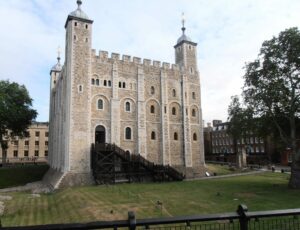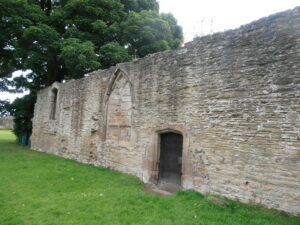Seven hundred years ago, on the first day of August in 1323, Roger Mortimer, the 1st Earl of March, one of the most notorious men in English medieval history, escaped from the Tower of London in what undoubtedly proved to be a cunning plan.
He was not the first prisoner to escape, or the last. Over the years since its construction in the 11th century there have been perhaps 40 successful attempts by determined prisoners. Two Jesuit prisoners used a rope stretching across the moat, in spite of their hands being crippled by torture. One Jacobite gentleman was aided and abetted by a female visitor into cross-dressing to fool the guards.
Not all who risked the dangers lived to tell the tale. In 1244 a Welsh rebel fell to his death from the White Tower. In the 17th Century Colonel Thomas Blood actually broke into the Tower to steal the crown jewels, but was then captured before he could escape with the crown, orb and sceptre.
Roger Mortimer’s escape was a conspicuous success, a dramatic tale of secret letters, of the use of drugs, of rope ladders, and not least the climbing over two of the all-but impregnable outer Tower walls.
Why was he imprisoned? Why did he need to risk his life to escape?
Roger Mortimer was a powerful nobleman, the owner of vast estates in the Welsh Marches and In Ireland. At the beginning of the reign of King Edward II he had been a loyal subject. That was until the royal favourite, Hugh Despenser, backed by the King, lay claim to lands in the Welsh Marches. This would be a threat to the Mortimer influence in that area. Roger Mortimer joined a rebellion and raised his banners against the favourite and against the King. The King considered this to be treason. Mortimer was arrested and shut in the Tower.
Mortimer planned his daring prison break when news was brought to him that his life was in immediate danger. He had been writing letters to rouse another rebellion throughout England. Some of these letters, smuggled out of the Tower, were intercepted and delivered to the King. There was no better way for the King to solve the problem than to have the letter-writing traitor killed, in effect hanged, drawn and probably quartered, as a lesson to all other would-be traitors. Better that Mortimer was dead than alive to plot. For Mortimer, better that he risk a spectacular escape. In effect, escape or die.
The event was cleverly planned for the night of the Feast of St Peter ad Vincula. St Peter was the patron saint of the church in the Tower, and it was the day on which ever year a feast was held for the garrison. The perfect day to choose, when the Tower community would be celebrating with the consumption of much food and alcohol. Mortimer had the promise of help from friends and collaborators both inside and outside the Tower.
This was how it was done.
At the feasting, the guards, including the Constable of the Tower, all indulging liberally in wine and ale, were drugged with some noxious concoction that would put them all to sleep for some considerable time. With the guards comatose, Mortimer was free to escape without supervision.
But how did he break out of his cell? Surely the Tower was impregnable, from within and without? In fact, the Tower was not always the formidable fortress that it might seem. Sadly some of the inner buildings had been allowed to fall into a dilapidated state, some of the chambers of the Tower in a bad state of decomposition, rain even coming through the roof of the royal apartments. In particular the kitchen roof was in disrepair, its timbers needed to be replaced and all re-tiled. Until that was done, there were significant holes. This was the perfect route for Roger Mortimer’s escape. He was able to break out through the crumbling walls of his cell, from where he could easily reach the kitchens.
There were still major difficulties to overcome, but Roger Mortimer had been supplied with rope ladders. Climbing out through a hole in the kitchen roof, he used a ladder to scale the inner curtain wall of the Tower into Water Lane. From there, with considerable athleticism, he could climb the outer wall to drop down to the bank of the River Thames. The drugs in the wine and beer obviously worked well. No one saw him or stopped him.
What of the collaborators? Was one of them Queen Isabella herself? Did she warn Mortimer of her husband’s plan to have him executed? We know that she spent time in the royal apartments in the Tower, and we know that when Roger Mortimer returned from exile he came in company with the Queen. But was Isabella one of the plotters who helped him to escape her husband’s vengeance? We will never know.
Once on the banks of the River Thames, all had been meticulously planned to get Mortimer out of England. Friends were already awaiting him with a boat to row him across to the opposite side. At a nearly mill, horses were also ready and waiting, and he was helped on his way, south towards the coast, to Portchester from where he took the waiting ship to the Isle of Wight, and then on to refuge across the sea in France.
It was certainly a nerve-racking time for Mortimer. On learning of the escape, the King had let loose a deadly hunt for his enemy throughout England, and particularly in the Welsh Marches or even on the routes to Ireland, but to no avail. Mortimer’s plans worked seamlessly and he evaded all pursuit. Sadly, Mortimer’s equally rebellious uncle, another Roger Mortimer of Chirk, was not able to join him in the escape and died in the Tower before his nephew could organise his release.
And the result of his escape? Mortimer’s wife Joan was suspected of being quite capable of stirring up rebellion in her husband’s name, and so was placed under restraint by King Edward, in Skipton Castle in Yorkshire. His children too were imprisoned, the girls sent either with their mother or to convents, the boys to be locked up behind the walls of Windsor Castle, all of them to live in near-destitute circumstances at the King’s orders during the years it took for Mortimer to plan his return.
Meanwhile, in France, Mortimer became the focus of attention to all who opposed the land-grabbing favourite Hugh Despenser. Eventually, three years after his escape, he was able to raise sufficient money and troops to aid his return to England, intent on recovering all the lands and titles that had been stripped from him. With him came Queen Isabella who had been living at the court of her father, the King of France. There is little doubt that by the time of their return they were lovers. And the rest is quite another story. The success of this escape from the Tower would result in the forced abdication of the King, the ruling power in England passing into the hands of Roger Mortimer and Queen Isabella.
On his return to England, Mortimer acknowledged the importance of the intervention of St Peter. God and his saints had quite definitely been on his side. Mortimer ordered the building of a chapel to St Peter ad Vincula within his castle at Ludlow, to give thanks for his escape. The chapel is still there but is now in ruins; the story of Roger Mortimer’s thrilling escape lives on.


